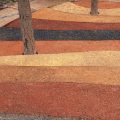Anthracnose
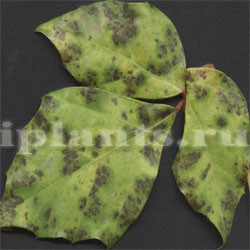 Diseases of indoor plants
Diseases of indoor plants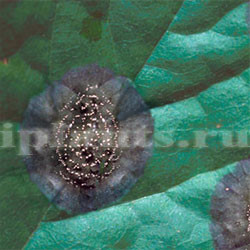
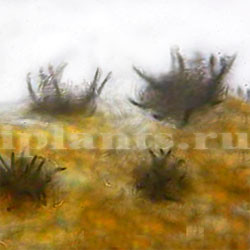 The causative agent is fungi of the genus Colletorichum,Gloeosporum. Affects leaves, stems, petioles and fruits of plants. At first, yellowish-brown spots with dark sporulation pads appear on the leaves and stems. The photo shows the spores of the fungus. If you look closely, you will notice that the spots on the upper side of the leaf do not have a smooth surface, but are covered with fluffy hairs of spores, but the spores are noticeable only when the plant is heavily affected. The spots look different on different plants. On clivia they can be reddish, on ivy - brown or gray-yellow, sometimes these are purple spots, and on some plants - very small yellowish-green spots, which then turn brown. As the disease develops, the spots increase in size, merge, the leaf turns brown and dries out. Anthracnose develops rapidly in greenhouse conditions, i.e. with high air humidity (about 90%) and elevated temperatures, as well as with frequent (several times a day) spraying of plants. The fungus is frost-resistant - it survives in plant debris, in seeds and spreads with water during irrigation. Prevention and treatment: Remove leaves with suspicious spots, disinfect the soil, treat seeds. If signs of the disease appear, it is necessary to reduce air humidity. Spray using chemicals. Among them are a 1% solution of Bordeaux mixture (100 g of copper sulfate + 100 g of lime per 10 l of water), a solution of copper oxychloride, copper sulfate (500 g per 10 l of water), colloidal sulfur (50-100 g per 10 l of water), strobi (in a system with other fungicides, 4 g per 10 l of water), Abiga-Peak (40-50 g per 10 l of water).
The causative agent is fungi of the genus Colletorichum,Gloeosporum. Affects leaves, stems, petioles and fruits of plants. At first, yellowish-brown spots with dark sporulation pads appear on the leaves and stems. The photo shows the spores of the fungus. If you look closely, you will notice that the spots on the upper side of the leaf do not have a smooth surface, but are covered with fluffy hairs of spores, but the spores are noticeable only when the plant is heavily affected. The spots look different on different plants. On clivia they can be reddish, on ivy - brown or gray-yellow, sometimes these are purple spots, and on some plants - very small yellowish-green spots, which then turn brown. As the disease develops, the spots increase in size, merge, the leaf turns brown and dries out. Anthracnose develops rapidly in greenhouse conditions, i.e. with high air humidity (about 90%) and elevated temperatures, as well as with frequent (several times a day) spraying of plants. The fungus is frost-resistant - it survives in plant debris, in seeds and spreads with water during irrigation. Prevention and treatment: Remove leaves with suspicious spots, disinfect the soil, treat seeds. If signs of the disease appear, it is necessary to reduce air humidity. Spray using chemicals. Among them are a 1% solution of Bordeaux mixture (100 g of copper sulfate + 100 g of lime per 10 l of water), a solution of copper oxychloride, copper sulfate (500 g per 10 l of water), colloidal sulfur (50-100 g per 10 l of water), strobi (in a system with other fungicides, 4 g per 10 l of water), Abiga-Peak (40-50 g per 10 l of water).
Ascochitis
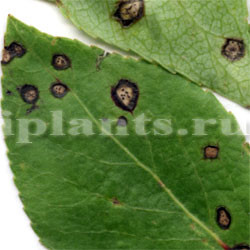
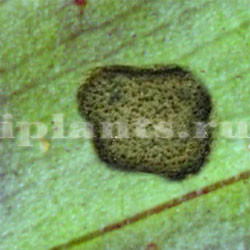
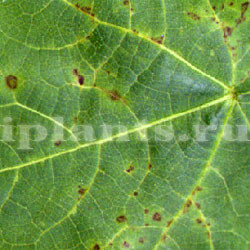 The causative agent is fungi of the genus Ascochyta.At the initial stage, small (only 1-2 mm) reddish or brown spots appear on the leaves and stems. The spots increase in size and acquire a dark brown necrotic shade with a yellowish chlorotic border along the edge. Small black spores of the fungus can only be seen under a magnifying glass. If the growth of the fungus on the stem encircles it, then the stem easily breaks. Sometimes the disease begins with signs of overdrying of the plant - the tips of the leaves begin to dry out, a dark brown stripe forms on the border with healthy tissue. The pathogen is very resistant to deep temperature changes, that is, it tolerates both severe drought and soil freezing. It persists on plant debris and seeds. The disease spreads with the wind, undisinfected soil, and drops of water. Prevention and treatment: as with anthracnose.
The causative agent is fungi of the genus Ascochyta.At the initial stage, small (only 1-2 mm) reddish or brown spots appear on the leaves and stems. The spots increase in size and acquire a dark brown necrotic shade with a yellowish chlorotic border along the edge. Small black spores of the fungus can only be seen under a magnifying glass. If the growth of the fungus on the stem encircles it, then the stem easily breaks. Sometimes the disease begins with signs of overdrying of the plant - the tips of the leaves begin to dry out, a dark brown stripe forms on the border with healthy tissue. The pathogen is very resistant to deep temperature changes, that is, it tolerates both severe drought and soil freezing. It persists on plant debris and seeds. The disease spreads with the wind, undisinfected soil, and drops of water. Prevention and treatment: as with anthracnose.
Phyllosticosis
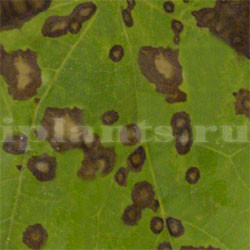
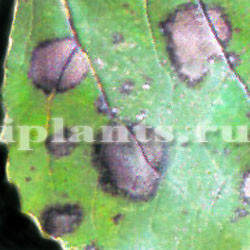
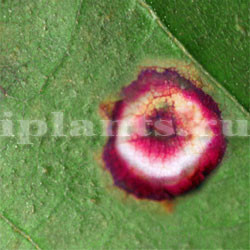 The causative agent is fungi of the genus Phyllosticta.Small black or dark purple dots initially appear on affected plants. They enlarge and turn into brown spots with a purple, almost black, border along the edge. The center of the spot becomes thinner, dries out and often falls out, holes are formed. When examined through a magnifying glass, black round spores can be seen on the brown areas of the spot. The disease spreads with wind, undisinfected soil, and water droplets. Prevention and treatment: as with anthracnose.
The causative agent is fungi of the genus Phyllosticta.Small black or dark purple dots initially appear on affected plants. They enlarge and turn into brown spots with a purple, almost black, border along the edge. The center of the spot becomes thinner, dries out and often falls out, holes are formed. When examined through a magnifying glass, black round spores can be seen on the brown areas of the spot. The disease spreads with wind, undisinfected soil, and water droplets. Prevention and treatment: as with anthracnose.
Septoria
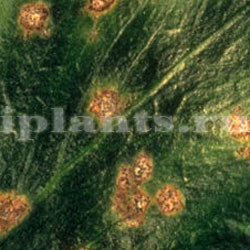
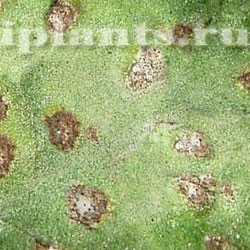
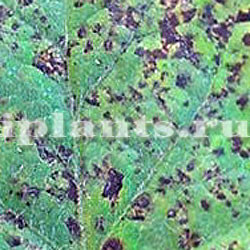 The causative agent is fungi of the genus Septoria.At first, small whitish or gray spots with a brown rim along the edge, round or oval in shape, appear. As the disease develops, the spots increase in size, and in the center of some of them, small dark brown or black fungal spores appear, which can be seen with the naked eye. Sometimes the resulting spots resemble rashes over the entire leaf. Over time, the spots merge, turn brown, and the leaf dries up. Ideal conditions for the development of the disease are high humidity and temperatures within 28-31°C. Prevention and treatment: Remove leaves with suspicious spots, disinfect the soil, and treat the seeds. At the first signs of the disease, it is necessary to reduce air humidity. Spray with chemicals. Among them are a 1% solution of Bordeaux mixture (100 g of copper sulfate + 100 g of lime per 10 l of water), a solution of copper oxychloride, copper sulfate (500 g per 10 l of water), colloidal sulfur (50-100 g per 10 l of water), strobi (in a system with other fungicides, 4 g per 10 l of water), Abiga-Peak (40-50 g per 10 l of water).
The causative agent is fungi of the genus Septoria.At first, small whitish or gray spots with a brown rim along the edge, round or oval in shape, appear. As the disease develops, the spots increase in size, and in the center of some of them, small dark brown or black fungal spores appear, which can be seen with the naked eye. Sometimes the resulting spots resemble rashes over the entire leaf. Over time, the spots merge, turn brown, and the leaf dries up. Ideal conditions for the development of the disease are high humidity and temperatures within 28-31°C. Prevention and treatment: Remove leaves with suspicious spots, disinfect the soil, and treat the seeds. At the first signs of the disease, it is necessary to reduce air humidity. Spray with chemicals. Among them are a 1% solution of Bordeaux mixture (100 g of copper sulfate + 100 g of lime per 10 l of water), a solution of copper oxychloride, copper sulfate (500 g per 10 l of water), colloidal sulfur (50-100 g per 10 l of water), strobi (in a system with other fungicides, 4 g per 10 l of water), Abiga-Peak (40-50 g per 10 l of water).
Powdery mildew
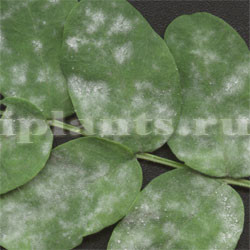
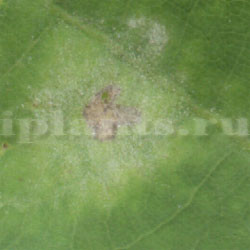
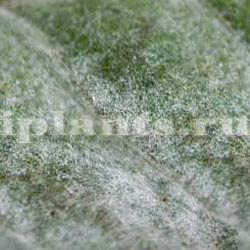 Pathogen - a large groupPowdery mildew fungi of the order Erysiphales. Among them, the most common fungi are of the genus Oidium, Sphaerotheca, etc. Signs of the disease are small spots on the upper side of the leaf, as if sprinkled with starch or flour. The coating is easily erased. Gradually, the spots increase in size, cover the entire leaf, and then the entire plant. Over time, the mycelium darkens and the white coating turns gray, and then brown, the leaves become deformed, dry out and fall off. Powdery mildew can form both on the outer and inner sides of the leaves. High air humidity (60-80%), relatively high temperatures (about 20°C), sharp temperature fluctuations (at night and during the day), as well as increased nitrogen content in the soil or fertilizing with nitrogen fertilizers contribute to the development of the disease. Prevention and treatment: Avoid excess nitrogen fertilizers in the soil, especially for flowering plants. Avoid crowding plants and stagnant, humid air. At the initial stage, when single spots appear, cut off the affected leaves and shoots. Treat the plant with a solution of soda ash (50 g of soda, 40 g of laundry soap per 10 liters of water). In case of severe damage, spray with 0.5% copper oxychloride, 1% colloidal sulfur, thiovit, and a mixture of antibiotics (100 units/ml of terramycin, 100 units/ml of penicillin, 250 units/ml of streptomycin, in a ratio of 1:1:1). You can use such drugs as Topaz, Vectra, Skor, Bayleton, etc.
Pathogen - a large groupPowdery mildew fungi of the order Erysiphales. Among them, the most common fungi are of the genus Oidium, Sphaerotheca, etc. Signs of the disease are small spots on the upper side of the leaf, as if sprinkled with starch or flour. The coating is easily erased. Gradually, the spots increase in size, cover the entire leaf, and then the entire plant. Over time, the mycelium darkens and the white coating turns gray, and then brown, the leaves become deformed, dry out and fall off. Powdery mildew can form both on the outer and inner sides of the leaves. High air humidity (60-80%), relatively high temperatures (about 20°C), sharp temperature fluctuations (at night and during the day), as well as increased nitrogen content in the soil or fertilizing with nitrogen fertilizers contribute to the development of the disease. Prevention and treatment: Avoid excess nitrogen fertilizers in the soil, especially for flowering plants. Avoid crowding plants and stagnant, humid air. At the initial stage, when single spots appear, cut off the affected leaves and shoots. Treat the plant with a solution of soda ash (50 g of soda, 40 g of laundry soap per 10 liters of water). In case of severe damage, spray with 0.5% copper oxychloride, 1% colloidal sulfur, thiovit, and a mixture of antibiotics (100 units/ml of terramycin, 100 units/ml of penicillin, 250 units/ml of streptomycin, in a ratio of 1:1:1). You can use such drugs as Topaz, Vectra, Skor, Bayleton, etc.
Downy mildew
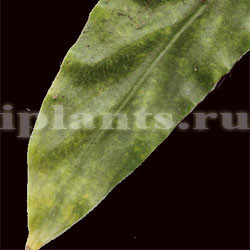
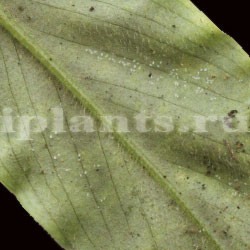
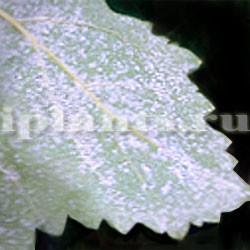 The causative agent is a fungus of the genus Peronospora.On the upper side of the leaves, yellow or brown spots of irregular shape are formed. On the underside of the leaves there is a light coating from the conidial sporulation of the pathogen that has come out onto the leaf surface through the stomata. Diseased leaves turn yellow and die prematurely. In case of severe damage, the pathogen can penetrate into the vascular system, which is noticeable on the cut as darkened vessels (mycelium and spores). The disease prevails on heavy acidic soils. High humidity and poor ventilation aggravate the spread. The source of infection is non-disinfected soil and seeds. Prevention and treatment: Hydrothermal treatment of seeds (immersion in hot water at 50°C for 20 minutes, followed by rapid cooling in cold water for 2–3 minutes). Careful removal of diseased leaves and severely affected plants. You can use "Oxychom", "Kuproksat", 1% solution of Bordeaux mixture. Start treatment at the first signs of the disease and repeat every 7-10 days, especially carefully treat the underside of the leaves. It is necessary to carry out at least 5 treatments.
The causative agent is a fungus of the genus Peronospora.On the upper side of the leaves, yellow or brown spots of irregular shape are formed. On the underside of the leaves there is a light coating from the conidial sporulation of the pathogen that has come out onto the leaf surface through the stomata. Diseased leaves turn yellow and die prematurely. In case of severe damage, the pathogen can penetrate into the vascular system, which is noticeable on the cut as darkened vessels (mycelium and spores). The disease prevails on heavy acidic soils. High humidity and poor ventilation aggravate the spread. The source of infection is non-disinfected soil and seeds. Prevention and treatment: Hydrothermal treatment of seeds (immersion in hot water at 50°C for 20 minutes, followed by rapid cooling in cold water for 2–3 minutes). Careful removal of diseased leaves and severely affected plants. You can use "Oxychom", "Kuproksat", 1% solution of Bordeaux mixture. Start treatment at the first signs of the disease and repeat every 7-10 days, especially carefully treat the underside of the leaves. It is necessary to carry out at least 5 treatments.
Rust
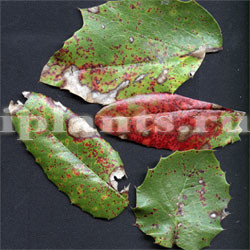
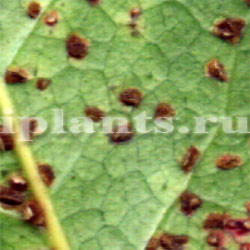
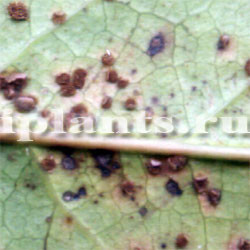 The causative agent is rust fungi, for examplegenus Phragmidium or Puccinia. It is expressed in the appearance of orange-brown tubercles, orange, yellow or red spots on the upper surface of the leaf. Pustules of oval or round shape are clearly visible on the back of the leaf. Gradually, the spots develop into stripes, the leaves turn yellow and fall off. The disease is provoked by uneven watering and high air humidity. Treatment: Remove affected leaves and branches. Spray with the following preparations: "Topaz", "Vectra", "Strobi", Bordeaux mixture, cuproxate. The treatment is repeated 2-3 times with a break of 10 days.
The causative agent is rust fungi, for examplegenus Phragmidium or Puccinia. It is expressed in the appearance of orange-brown tubercles, orange, yellow or red spots on the upper surface of the leaf. Pustules of oval or round shape are clearly visible on the back of the leaf. Gradually, the spots develop into stripes, the leaves turn yellow and fall off. The disease is provoked by uneven watering and high air humidity. Treatment: Remove affected leaves and branches. Spray with the following preparations: "Topaz", "Vectra", "Strobi", Bordeaux mixture, cuproxate. The treatment is repeated 2-3 times with a break of 10 days.
Gray mold

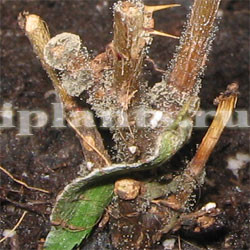
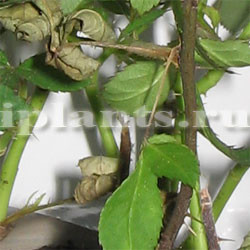 The causative agent is fungi of the genus Botrytis.Most often, the affected areas appear on the stems in the form of a fluffy grayish-olive coating. With further development, the disease spreads to the leaves, flower ovaries and fruits. Over time, the lesion takes the form of dry rot with concentric spots. After a few days, the spot grows and rings the stem. During the first week, there is no sporulation of the fungus on the spot, it fades in the center to a straw color, and blurred ring-shaped stripes become visible. Tissue necrosis develops inside the stem, while the vessels die off and water movement stops. The shoot above this zone withers. The pathogen belongs to the so-called wound parasites, the infection spreads mainly with wind, dust, splashes of water, unwashed hands, etc. Poor lighting, high air humidity, dense group plantings, and an optimal temperature for the development of the disease also contribute to the spread of the disease - 17–25°S. Prevention and treatment: Preventive measures include disinfection of the soil. Regular ventilation of the premises, removal of dying leaves and thinning of seedlings, good lighting. Avoid over-moistening of the soil, especially when kept cool. Adding to the soil before planting the preparations "Trichodermin", "Barrier" or "Zaslon". At the first signs of the disease, remove diseased leaves and inflorescences. The affected area is sprinkled with charcoal powder, chalk, ash or potassium permanganate. You can make a paste from the preparation Trichodermin (moisten a small amount of powder with water) and smear the affected areas. Spraying with a solution of topsin-M (0.1%), foundationol (0.2%), copper-soap solution (0.2% copper sulfate and 2% laundry soap), 0.05% bayleton solution. Repeated treatments are carried out after 10-12 days.
The causative agent is fungi of the genus Botrytis.Most often, the affected areas appear on the stems in the form of a fluffy grayish-olive coating. With further development, the disease spreads to the leaves, flower ovaries and fruits. Over time, the lesion takes the form of dry rot with concentric spots. After a few days, the spot grows and rings the stem. During the first week, there is no sporulation of the fungus on the spot, it fades in the center to a straw color, and blurred ring-shaped stripes become visible. Tissue necrosis develops inside the stem, while the vessels die off and water movement stops. The shoot above this zone withers. The pathogen belongs to the so-called wound parasites, the infection spreads mainly with wind, dust, splashes of water, unwashed hands, etc. Poor lighting, high air humidity, dense group plantings, and an optimal temperature for the development of the disease also contribute to the spread of the disease - 17–25°S. Prevention and treatment: Preventive measures include disinfection of the soil. Regular ventilation of the premises, removal of dying leaves and thinning of seedlings, good lighting. Avoid over-moistening of the soil, especially when kept cool. Adding to the soil before planting the preparations "Trichodermin", "Barrier" or "Zaslon". At the first signs of the disease, remove diseased leaves and inflorescences. The affected area is sprinkled with charcoal powder, chalk, ash or potassium permanganate. You can make a paste from the preparation Trichodermin (moisten a small amount of powder with water) and smear the affected areas. Spraying with a solution of topsin-M (0.1%), foundationol (0.2%), copper-soap solution (0.2% copper sulfate and 2% laundry soap), 0.05% bayleton solution. Repeated treatments are carried out after 10-12 days.
Black rot, or Alternaria
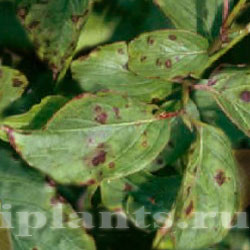
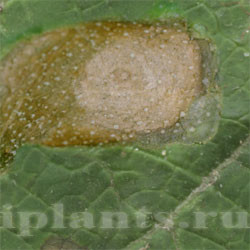
 The causative agent is fungi of the genus Alternaria.The fungus mainly affects leaves, sometimes stems and tubers. Dry brown spots first appear, primarily on the lower leaves, then on the upper leaves. Concentric circles are usually visible on the spots. As the spot grows, it gradually turns black, and gray condidia become visible on it. Frequent temperature changes and changes in humidity, that is, alternation of dry and wet periods, contribute to the spread of the disease. But the optimal conditions for the development of the fungus are at a temperature above 18 ° C and humidity of about 90%. Treatment: Preparations used to combat alternaria include cuproxate, copper sulfate, Bordeaux mixture, cupricol, copper oxychloride, Abiga-Peak, Maxim.
The causative agent is fungi of the genus Alternaria.The fungus mainly affects leaves, sometimes stems and tubers. Dry brown spots first appear, primarily on the lower leaves, then on the upper leaves. Concentric circles are usually visible on the spots. As the spot grows, it gradually turns black, and gray condidia become visible on it. Frequent temperature changes and changes in humidity, that is, alternation of dry and wet periods, contribute to the spread of the disease. But the optimal conditions for the development of the fungus are at a temperature above 18 ° C and humidity of about 90%. Treatment: Preparations used to combat alternaria include cuproxate, copper sulfate, Bordeaux mixture, cupricol, copper oxychloride, Abiga-Peak, Maxim.
Wilt, or Verticillium wilt
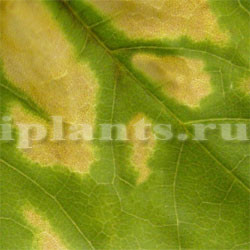
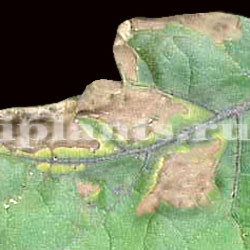
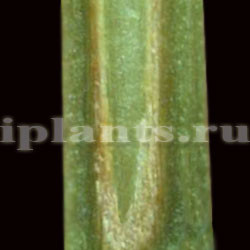 The causative agent is a fungus of the genus Verticillium.At the initial stages of the disease, the lower leaves acquire a grayish-greenish color due to the development of interveinal necrosis. The leaf tissue between the veins turns brown and dries out. Then wilting begins, most of the leaves, starting from the bottom, turn yellow, curl up and dry out. Browning of the vessels is noticeable on the cut of the stem. The lumens of the vessels are filled with thin multicellular mycelium. Plants lag in growth, develop poorly, and then die. Sometimes the disease manifests itself on the plant in the drying out and dying off of individual branches of the bush. If the conditions are favorable, the disease spreads to other branches and the entire plant dies quite quickly. If unfavorable conditions for the development of the fungus develop, the disease can last for months and part of the plant looks healthy, and part dies. The pathogen persists in the soil in the form of microsclerotia for several years. The optimal temperature for the germination of sclerotia is 24–26°, humidity 60–70%. The fungus is most likely to develop on soil with a neutral pH of 7–7.5. The fungus spores germinate and penetrate the conducting tissue, where mycelium develops, causing clogging of the vessels. Since the vessels are gradually clogged from the bottom up, the wilting of the leaves begins with the lower leaves and gradually affects the entire plant. Treatment: Disinfection of the soil by steaming, disinfection of seeds by heating, application of trichodermin or Agate to the soil. Chemical agents are not effective due to the specific biology of the pathogen (development in the soil and spread through the conducting vessels). Treatment is possible only in the initial stages, by spraying with Fundazole, Vectra or Topsin-M at a concentration of 0.2%.
The causative agent is a fungus of the genus Verticillium.At the initial stages of the disease, the lower leaves acquire a grayish-greenish color due to the development of interveinal necrosis. The leaf tissue between the veins turns brown and dries out. Then wilting begins, most of the leaves, starting from the bottom, turn yellow, curl up and dry out. Browning of the vessels is noticeable on the cut of the stem. The lumens of the vessels are filled with thin multicellular mycelium. Plants lag in growth, develop poorly, and then die. Sometimes the disease manifests itself on the plant in the drying out and dying off of individual branches of the bush. If the conditions are favorable, the disease spreads to other branches and the entire plant dies quite quickly. If unfavorable conditions for the development of the fungus develop, the disease can last for months and part of the plant looks healthy, and part dies. The pathogen persists in the soil in the form of microsclerotia for several years. The optimal temperature for the germination of sclerotia is 24–26°, humidity 60–70%. The fungus is most likely to develop on soil with a neutral pH of 7–7.5. The fungus spores germinate and penetrate the conducting tissue, where mycelium develops, causing clogging of the vessels. Since the vessels are gradually clogged from the bottom up, the wilting of the leaves begins with the lower leaves and gradually affects the entire plant. Treatment: Disinfection of the soil by steaming, disinfection of seeds by heating, application of trichodermin or Agate to the soil. Chemical agents are not effective due to the specific biology of the pathogen (development in the soil and spread through the conducting vessels). Treatment is possible only in the initial stages, by spraying with Fundazole, Vectra or Topsin-M at a concentration of 0.2%.
Fusarium wilt (tracheomycosis)
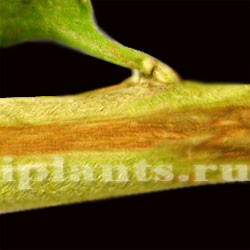
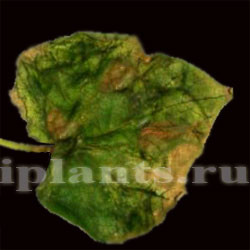
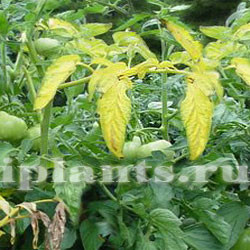 The causative agent is a fungus of the genus Fusarium.Fusarium develops only on weakened plants, primarily on dying areas. The course of the disease can be like tracheomycotic wilt or with root rot. The tops of the shoots of affected plants wilt (loss of turgor), and then the entire shoot. This happens, as in the case of wilt infection, due to the blockage of blood vessels by toxins secreted by fungi. Therefore, darkening of the vessels is also noticeable on the cross-section. If the top is cut off in time, it can be rooted and a healthy plant can be obtained. But this will only be possible if the fungus has not reached the top of the shoot through the vessels. The rate of progression of the disease depends on how favorable the conditions are for the development of the fungus. With high soil and air humidity, as well as temperatures above 18 ° C, the disease can destroy the entire plant in a few days. If the humidity is low, the disease can become chronic, then the plant slowly withers over 3-4 weeks. Root rot also most often has a specific picture: strong thick roots remain normal, and small ones rot. The source of infection can be non-disinfected soil, water from natural sources, non-sterile instruments. Prevention and treatment: Removal and destruction of the plant together with the soil lump. Disinfection of pots with a 5% solution of copper sulfate, bleach. If wilting has just begun, you can try to treat the plant with Vectra or Benomyl. You can save the plant by cutting off the apical stalk and re-rooting it. pouring it thoroughly with a solution of potassium permanganate of a slightly pink color, phytosporin-M, Maxim or adding trichodermin. When working, sterilize the tools - knife, scissors and even garter material (wire, threads) with alcohol. When using water from natural reservoirs or rainwater, use the drug Fitosporin-M. By the way, fusarium on indoor plants manifests itself in the same way as on garden crops (see the tomato bush in the photo).
The causative agent is a fungus of the genus Fusarium.Fusarium develops only on weakened plants, primarily on dying areas. The course of the disease can be like tracheomycotic wilt or with root rot. The tops of the shoots of affected plants wilt (loss of turgor), and then the entire shoot. This happens, as in the case of wilt infection, due to the blockage of blood vessels by toxins secreted by fungi. Therefore, darkening of the vessels is also noticeable on the cross-section. If the top is cut off in time, it can be rooted and a healthy plant can be obtained. But this will only be possible if the fungus has not reached the top of the shoot through the vessels. The rate of progression of the disease depends on how favorable the conditions are for the development of the fungus. With high soil and air humidity, as well as temperatures above 18 ° C, the disease can destroy the entire plant in a few days. If the humidity is low, the disease can become chronic, then the plant slowly withers over 3-4 weeks. Root rot also most often has a specific picture: strong thick roots remain normal, and small ones rot. The source of infection can be non-disinfected soil, water from natural sources, non-sterile instruments. Prevention and treatment: Removal and destruction of the plant together with the soil lump. Disinfection of pots with a 5% solution of copper sulfate, bleach. If wilting has just begun, you can try to treat the plant with Vectra or Benomyl. You can save the plant by cutting off the apical stalk and re-rooting it. pouring it thoroughly with a solution of potassium permanganate of a slightly pink color, phytosporin-M, Maxim or adding trichodermin. When working, sterilize the tools - knife, scissors and even garter material (wire, threads) with alcohol. When using water from natural reservoirs or rainwater, use the drug Fitosporin-M. By the way, fusarium on indoor plants manifests itself in the same way as on garden crops (see the tomato bush in the photo).
Bacterial, or wet rot
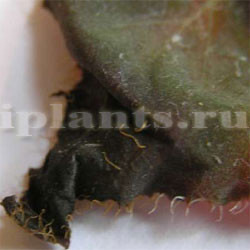
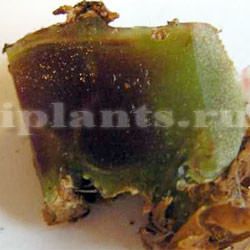
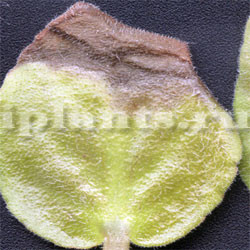 The causative agent is the bacterium of childbirthPectobacterium, Erwinia. The disease manifests itself in the softening and decay of individual areas on the leaves, petioles, roots and fruits of the plant. Bacteria secrete the enzyme pectinase into the leaf tissue, which causes tissue decay. Most often, juicy and fleshy parts of plants are susceptible to damage. At first, a small shapeless spot appears on the leaves, gray, brown or black, which gradually grows. Rotting begins on the bulbs and tubers, often accompanied by an unpleasant odor. Under favorable conditions - in a warm and humid climate - the disease spreads very quickly. The affected part or the entire plant turns into a soggy mass. The pathogen penetrates through mechanical damage to the plant - even microscopic cracks and wounds. It is preserved in the soil with plant residues. Prevention and treatment: Disinfection of the soil is required before planting, and when cutting roots, tubers and bulbs, the cuts must be sprinkled with crushed charcoal. The tool must be disinfected with alcohol after each cut. The development of the disease is provoked by the introduction of excessive doses of fertilizers, stagnation of water in the soil, dense, compacted soil, cooling of damp soil in pots, for example in winter in a cool room. The plant can be saved if bacteriosis has not yet affected the entire vascular system or is local (for example, rot began from the tip of the leaf). If the roots have rotted, you can try to root the top (if this plant is rooted by cuttings). If rot has affected only part of the roots, and the above-ground part looks alive, you can try to save the plant, — To do this, you need to free the roots from the ground, cut off all the rotten ones, transplant into dry prepared soil, water and spray with Bordeaux mixture (or copper-containing preparations). The infection will not spread to another plant standing nearby, but all working tools and pots must be thoroughly disinfected.
The causative agent is the bacterium of childbirthPectobacterium, Erwinia. The disease manifests itself in the softening and decay of individual areas on the leaves, petioles, roots and fruits of the plant. Bacteria secrete the enzyme pectinase into the leaf tissue, which causes tissue decay. Most often, juicy and fleshy parts of plants are susceptible to damage. At first, a small shapeless spot appears on the leaves, gray, brown or black, which gradually grows. Rotting begins on the bulbs and tubers, often accompanied by an unpleasant odor. Under favorable conditions - in a warm and humid climate - the disease spreads very quickly. The affected part or the entire plant turns into a soggy mass. The pathogen penetrates through mechanical damage to the plant - even microscopic cracks and wounds. It is preserved in the soil with plant residues. Prevention and treatment: Disinfection of the soil is required before planting, and when cutting roots, tubers and bulbs, the cuts must be sprinkled with crushed charcoal. The tool must be disinfected with alcohol after each cut. The development of the disease is provoked by the introduction of excessive doses of fertilizers, stagnation of water in the soil, dense, compacted soil, cooling of damp soil in pots, for example in winter in a cool room. The plant can be saved if bacteriosis has not yet affected the entire vascular system or is local (for example, rot began from the tip of the leaf). If the roots have rotted, you can try to root the top (if this plant is rooted by cuttings). If rot has affected only part of the roots, and the above-ground part looks alive, you can try to save the plant, — To do this, you need to free the roots from the ground, cut off all the rotten ones, transplant into dry prepared soil, water and spray with Bordeaux mixture (or copper-containing preparations). The infection will not spread to another plant standing nearby, but all working tools and pots must be thoroughly disinfected.
Bacterial blotch, bacterial burn, vascular bacteriosis
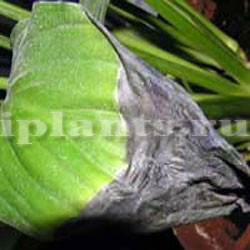
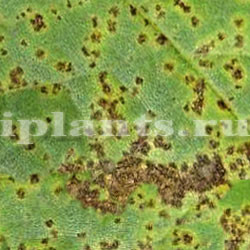
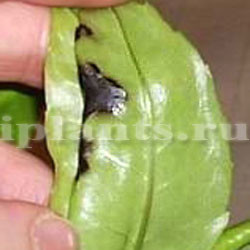 The causative agent is bacteria of the genus Xanthomonas,Pseudomonas. The disease most often affects young leaves and shoots. Bacterial spots have different symptoms depending on the species. The most typical picture is when small watery spots first form on the surface of the leaf or stem, which gradually turn black. Most often, the spots have an irregular angular shape and are bordered by a yellow or light green border. The bacterium most often spreads along the veins. The spots grow, merge, and the entire leaf turns black. Ultimately, the plant dies. Optimal conditions for the development of bacteria are a temperature of 25-30°C and high humidity. Bacteria die only at temperatures above 56°C. Bacteria of the genus Xanthomonas are resistant to drying and can tolerate low temperatures for a long time. A variant of bacterial spotting is the so-called bacterial burn, which is caused by bacteria of the genus Pseudomonas. In this case, the plant does not develop spots, but rather large, shapeless areas of blackening, which then dry out. It looks as if a section of the leaf is burnt. If the disease is accompanied by favorable conditions, it develops very quickly, causing the death of individual parts and the death of the entire plant. Bacterial burn usually begins with young leaves, shoots and flowers. Bacteria penetrate plants through stomata or wounds and begin to multiply in the intercellular spaces of the leaf parenchyma. The incubation period for the development of the disease is 3-6 days, depending on the temperature. Bacteria persist in the soil and on seeds. Prevention and treatment: On garden crops, plants are treated and seeds are treated with the antibiotic phytolavin-300. At home, spraying and watering the soil with a solution of trichopolum (1 tablet per 2 liters of water) is successfully used for indoor plants. Copper-containing preparations such as Bordeaux mixture, copper sulfate, and the systemic fungicide Maxim are also effective.
The causative agent is bacteria of the genus Xanthomonas,Pseudomonas. The disease most often affects young leaves and shoots. Bacterial spots have different symptoms depending on the species. The most typical picture is when small watery spots first form on the surface of the leaf or stem, which gradually turn black. Most often, the spots have an irregular angular shape and are bordered by a yellow or light green border. The bacterium most often spreads along the veins. The spots grow, merge, and the entire leaf turns black. Ultimately, the plant dies. Optimal conditions for the development of bacteria are a temperature of 25-30°C and high humidity. Bacteria die only at temperatures above 56°C. Bacteria of the genus Xanthomonas are resistant to drying and can tolerate low temperatures for a long time. A variant of bacterial spotting is the so-called bacterial burn, which is caused by bacteria of the genus Pseudomonas. In this case, the plant does not develop spots, but rather large, shapeless areas of blackening, which then dry out. It looks as if a section of the leaf is burnt. If the disease is accompanied by favorable conditions, it develops very quickly, causing the death of individual parts and the death of the entire plant. Bacterial burn usually begins with young leaves, shoots and flowers. Bacteria penetrate plants through stomata or wounds and begin to multiply in the intercellular spaces of the leaf parenchyma. The incubation period for the development of the disease is 3-6 days, depending on the temperature. Bacteria persist in the soil and on seeds. Prevention and treatment: On garden crops, plants are treated and seeds are treated with the antibiotic phytolavin-300. At home, spraying and watering the soil with a solution of trichopolum (1 tablet per 2 liters of water) is successfully used for indoor plants. Copper-containing preparations such as Bordeaux mixture, copper sulfate, and the systemic fungicide Maxim are also effective.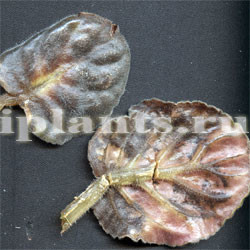 Vascular bacteriosis
Vascular bacteriosis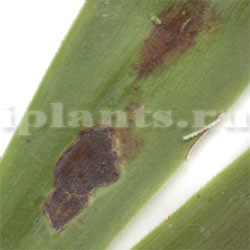 Bacterial Spotting
Bacterial Spotting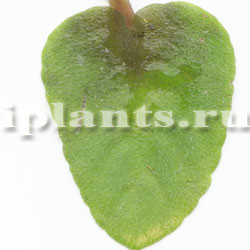 Vascular bacteriosis
Vascular bacteriosis
conclusions
For most flower growers, the main thing isточное определение заболевания. Тем не менее, в большинстве случаев это вызывает затруднения. Чтобы установить причину болезни, важно собрать как можно больше симптомов наблюдаемых повреждений, изменений в росте и развитии. В первую очередь необходимо определиться с условиями, в которых находилось растение. Так, например, большинство болезней грибкового и бактериального происхождения развиваются в условиях повышенной влажности и при высоких температурах. Однако это не значит, что если растение не опрыскивалось и содержалось в прохладе, на нем не может быть болезней. Они могут быть, но распространяться будут значительно медленнее, чем в тепличных условиях. Иными словами, болезнь может проходить в хронической затяжной форме, а может вызвать гибель растения буквально за несколько дней. Часто болезни путают с проявлениями нарушений ухода. Если цветок страдает от пересушки земли или сухого воздуха, проявляется это в первую очередь усыханием кончиков листьев, побледнением и потерей тургора, однако может сопровождаться и появлением клещика, вызывающего скручивание и деформацию листьев, а также образование характерных пятен-проколов. Растения, недополучающие влагу из воздуха и почвы редко страдают от болезней (бактериальных и грибковых), но в силу ослабленности попадают в группу риска. А вот растения, страдающие от перелива, находящиеся в условиях повышенной влажности (в теплом или прохладном помещении), опрыскиваемые несколько раз в день, посаженные в непродезинфицированную почву, а также выставленные на открытый воздух, растущие в большой группе или в плохо проветриваемых помещениях — первые окажутся зараженными как грибковыми, так и бактериальными болезнями. Есть болезни, которые очень легко идентифицируются по характерным симптомам — это, например, мучнистая роса, серая гниль. Другие болезни можно определить по наличию спор, иногда крупных и легко заметных невооруженным глазом, а иногда, особенно на начальной стадии, видимых только через лупу. Бактерии же, вообще, можно рассмотреть только при большом увеличении микроскопа. Чаще всего по характеру пятен очень сложно определить патогена. Так бактериозы вызывают различные виды пятнистостей, некрозов и увядание (поражение сосудистой системы растения), но отличить их от вертициллезного или фузариозного увядания можно только по срезу стебля в месте поражения. Нередко ослабленные недостатком света или другими нарушениями условий содержания (особенно после содержания в сомнительных магазинчиках) растения страдают не одним, а сразу несколькими недугами. Например, поражаются клещиком и бактериальной пятнистостью. При этом, когда начинают усиленную борьбу опрыскиванием против клеща, на растении начинает не только усиленно развиваться бактериоз, но и заодно серая гниль (грибковое заболевание). В конечном счете растение погибает, потому что не в состоянии бороться сразу с несколькими напастями, особенно если оно еще не акклиматизировалось в новых условиях. Поэтому не стоит впадать в крайность и резко менять условия содержания, и потом, если вокруг растения повышенная влажность, просто помните, что ему могут угрожать все возможные болезни. Ведь они разносятся с ветром, брызгами воды, легко переносятся с инструментом, руками и на лапках насекомых, а также с водой из природных источников. Микроскопической трещинки на кожице растения достаточно для проникновения бактерии. Что касается лечения, то очень часто достаточно удалить поврежденные пятнами листья, улучшить условия содержания, и болезнь проходит. Если этого не наступает или болезнь запущена слишком сильно, тогда приходится прибегать к применению фунгицидов. Итак, когда стоит беспокоиться и принимать вероятность возникновения пятен, некрозов и увядания по причине болезней грибкового и бактериального происхождения:
- if the plant is planted in non-disinfected soil;
- if the plant is bought in the store;
- if the plant was (is) in conditions of high humidity;
- if the plant is (was) in a crowded group, or in an unventilated room;
- if you have examined the entire plant with a magnifying glass and have not found any visible pest (if you do not have a magnifying glass, you can not even try to identify the damage);
- if the plant is watered with water from natural sources (rain, pond, river), and also stands outdoors.
- if the plant is overwatered or has been overwatered.
- if the plant was not transplanted into high-quality soil in time (if the nutrition is poor, similar symptoms may be observed - spotting, chlorosis, growth retardation);
- Lack of light aggravates the development of all diseases!







